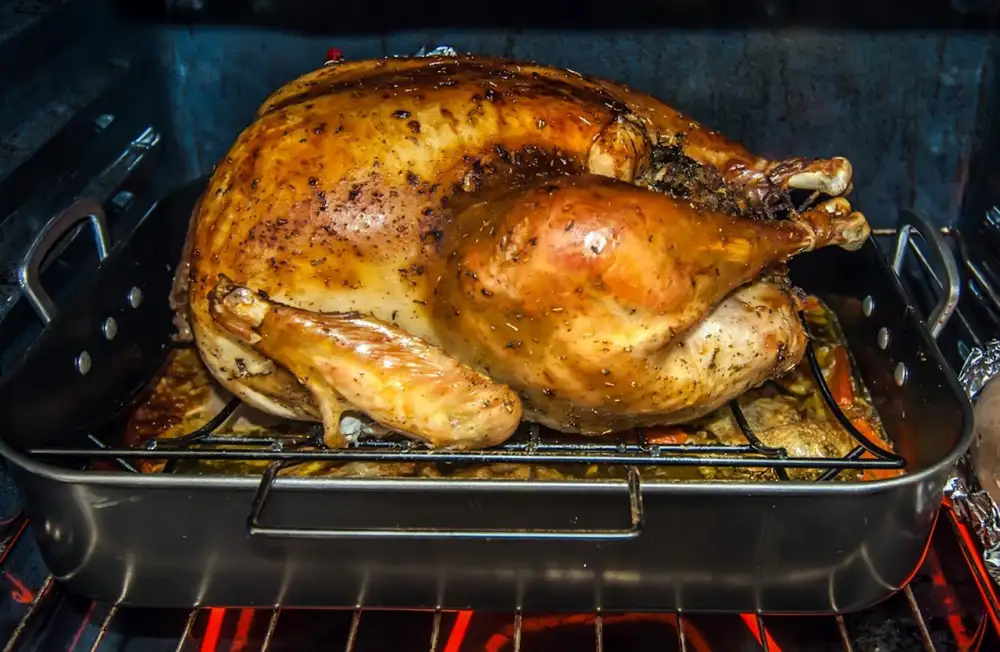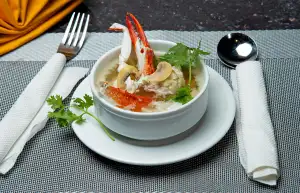Master the Art of Roasting a Turkey: A Step-by-Step Guide to Perfectly Roasted Poultry

Roasting a turkey is an art that has been perfected over generations. It is a culinary tradition that brings families together and creates memories around the dinner table. Whether it's Thanksgiving or any other special occasion, roasting a turkey is a skill worth mastering.
The process of roasting a turkey involves slow cooking the bird in an oven, allowing the flavors to develop and the meat to become tender and juicy. The result is a golden brown, succulent centerpiece that will impress your guests.
In this step-by-step guide, we will take you through the journey of roasting a turkey, from choosing the perfect bird to serving it with finesse. Get ready to embark on a culinary adventure and become a master of roasting poultry!
Choosing the Perfect Turkey for Roasting
When it comes to roasting a turkey, selecting the right bird is crucial. Here are some tips to help you choose the perfect turkey for your roast:
1. Size matters: Consider the number of guests you will be serving and plan accordingly. A general rule of thumb is to estimate about 1 pound (0.45 kg) of turkey per person.
2. Fresh or frozen: Decide whether you want a fresh or frozen turkey. Fresh turkeys tend to have better flavor and texture, but they can be harder to find and more expensive. Frozen turkeys are more readily available and can be purchased in advance.
3. Quality matters: Look for a turkey that is plump with firm, moist skin. Avoid any signs of discoloration or dryness, as these indicate an older bird.
4. Organic or conventional: Consider whether you want an organic or conventionally raised turkey. Organic turkeys are raised without antibiotics or hormones and are fed organic diets, resulting in a more natural and flavorful bird.
5. Heritage breed: For those looking for a unique flavor experience, consider opting for a heritage breed turkey. These birds are bred from traditional breeds and often have richer flavors compared to commercial breeds.
Remember, choosing the perfect turkey sets the foundation for a delicious roast, so take your time and select one that meets your preferences and requirements.
Preparing the Turkey for Roasting
1. Thawing: Ensure that your turkey is completely thawed before roasting. Place it in the refrigerator for 24 hours per 4-5 pounds of turkey.
2. Cleaning: Rinse the turkey thoroughly with cold water, inside and out. Pat dry with paper towels.
3. Removing Giblets: Check the body cavity for giblets (heart, liver, gizzard). Remove them and set aside for other uses or discard.
4. Trimming Excess Fat: Trim any excess fat from the turkey's neck and body cavity to prevent excessive grease during cooking.
5. Tucking Wings and Legs: Fold the wings under the back of the turkey and tie the legs together with kitchen twine to ensure even cooking.
6. Stuffing (optional): If you choose to stuff your turkey, do so just before roasting. Fill the cavity loosely with stuffing, as it will expand during cooking.
7. Preheating Oven: Preheat your oven to 325°F (165°C) while you prepare the seasoning and flavorings for your turkey.
Remember, proper preparation is key to a deliciously roasted turkey!
Seasoning and Flavoring the Turkey
Once you have prepared the turkey for roasting, it's time to add some delicious flavors. Start by generously seasoning the turkey with salt and pepper. This will enhance the natural taste of the meat.
Next, consider adding herbs and spices to elevate the flavor profile. Traditional options include rosemary, thyme, sage, and garlic. You can either sprinkle these directly onto the turkey or create a paste by mixing them with butter or olive oil.
For a more adventurous twist, experiment with different spice blends such as paprika, cumin, or chili powder. These will add a unique kick to your roasted turkey.
To infuse even more flavor into the meat, try marinating it overnight in a mixture of citrus juice (such as lemon or orange), soy sauce, honey, and your choice of herbs and spices. This will result in a moist and flavorful turkey.
Remember to baste the turkey periodically during roasting to keep it moist and ensure that the flavors penetrate evenly. Use a basting brush or spoon to drizzle pan juices over the bird every 30 minutes or so.
By seasoning and flavoring your turkey properly, you can take it from ordinary to extraordinary. The combination of herbs, spices, and marinades will create a mouthwatering aroma that will leave your guests craving for more.
Roasting the Turkey to Perfection
1. Preheat the oven to 325°F (165°C). Place the turkey on a rack in a roasting pan, breast side up.
2. Brush the turkey with melted butter or olive oil to ensure a crispy and golden skin.
3. Insert an oven-safe meat thermometer into the thickest part of the thigh without touching the bone. This will help you monitor the internal temperature.
4. Roast the turkey uncovered for about 15 minutes per pound, or until the thermometer reads 165°F (74°C) in the thigh and 160°F (71°C) in the breast.
5. Baste the turkey every 30 minutes with pan drippings or a mixture of broth and melted butter to keep it moist and flavorful.
6. To achieve an evenly cooked bird, rotate the roasting pan halfway through cooking time.
7. Tent the turkey loosely with aluminum foil if it starts browning too quickly, ensuring that it doesn't touch the skin.
8. Let the roasted turkey rest for at least 20 minutes before carving to allow juices to redistribute and ensure maximum tenderness.
Remember, cooking times may vary depending on your oven and size of the turkey, so always rely on internal temperature rather than just time. With these steps, you'll have a perfectly roasted turkey that will impress your guests!
Tips for Juicy and Tender Turkey
To ensure a juicy and tender turkey, follow these tips:
1. Brining: Brining the turkey before roasting is a game-changer. Soak the turkey in a mixture of water, salt, sugar, and spices for at least 12 hours. This process adds moisture to the meat, resulting in a succulent bird.
2. Basting: Basting the turkey with its own juices or a flavorful marinade throughout the cooking process helps keep it moist. Use a basting brush or spoon to coat the skin every 30 minutes.
3. Trussing: Trussing involves tying the legs and wings of the turkey together using kitchen twine. This technique promotes even cooking and prevents drying out of certain parts.
4. Using a Meat Thermometer: Invest in a reliable meat thermometer to accurately gauge when your turkey is done. Insert it into the thickest part of the thigh without touching bone; it should read 165°F (74°C) for perfectly cooked meat.
5. Resting Time: Allow your roasted turkey to rest for at least 20-30 minutes before carving. This allows the juices to redistribute throughout the meat, resulting in moist and tender slices.
By following these tips, you'll be able to achieve a succulent and tender turkey that will impress your guests this holiday season!
Serving and Garnishing the Roasted Turkey
Once your turkey is perfectly roasted, it's time to present it in an appetizing and visually appealing manner. Carefully transfer the turkey onto a large serving platter, using two sturdy utensils to maintain its shape. Allow the turkey to rest for at least 15 minutes before carving to ensure the juices are distributed evenly.
To garnish the roasted turkey, consider using fresh herbs such as rosemary, thyme, or sage. These not only add a pop of color but also enhance the aroma of the dish. Place a few sprigs strategically around the turkey or tuck them into the cavity for an elegant touch.
For additional visual appeal, you can surround the turkey with roasted vegetables like carrots, Brussels sprouts, or parsnips. These colorful and flavorful side dishes complement the turkey beautifully and add variety to your presentation.
To further elevate your presentation, consider drizzling some homemade gravy over the carved slices of turkey just before serving. This adds richness and enhances both taste and appearance.
Remember that garnishing is not just about aesthetics; it also plays a role in enhancing flavors. Consider adding citrus slices like oranges or lemons alongside the turkey for a burst of freshness.
Lastly, don't forget to provide appropriate serving utensils and carving knives for your guests' convenience. A well-presented roasted turkey will surely be a centerpiece that impresses everyone at your dining table.
Mastering the art of serving and garnishing a roasted turkey will take your culinary skills to new heights and make your Thanksgiving or Christmas feast truly memorable.
Variations and Alternative Methods for Roasting a Turkey
While the traditional method of roasting a turkey is undeniably delicious, there are several variations and alternative methods that can add a unique twist to your Thanksgiving feast. Here are a few ideas to consider:
1. Smoked Turkey: For a smoky flavor, try smoking your turkey instead of roasting it. Use wood chips like hickory or applewood to infuse the meat with a rich, smoky taste.
2. Herb-Infused Butter: Create an herb-infused butter by mixing softened butter with chopped herbs like rosemary, thyme, and sage. Rub this mixture under the skin of the turkey before roasting for an extra burst of flavor.
3. Beer Can Turkey: This method involves placing an open beer can inside the cavity of the turkey and standing it upright on the grill or in the oven. The steam from the beer keeps the meat moist and adds a unique flavor.
4. Spatchcocked Turkey: Spatchcocking involves removing the backbone of the turkey and flattening it out before roasting. This method reduces cooking time and ensures even cooking throughout.
5. Deep-Fried Turkey: Deep-frying a turkey results in incredibly crispy skin and juicy meat. However, caution must be exercised as deep-frying can be dangerous if not done properly.
Remember to always follow proper safety precautions when trying alternative methods, such as monitoring cooking temperatures and handling hot oil carefully. These variations can elevate your turkey game and impress your guests with new flavors and textures.
In conclusion, mastering the art of roasting a turkey is a skill that can elevate your culinary prowess. By following the step-by-step guide outlined in this article, you can achieve a perfectly roasted turkey every time. Remember to choose the perfect turkey for roasting, prepare it properly, season and flavor it to your liking, and roast it with care. Use the tips provided to ensure juicy and tender meat. Finally, serve your masterpiece with garnishes that complement its flavors. With practice and experimentation, you can also explore variations and alternative methods for roasting a turkey. So go ahead, impress your family and friends with a beautifully roasted turkey that will be the centerpiece of any festive occasion!
Published: 21. 11. 2023
Category: Food



